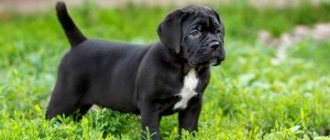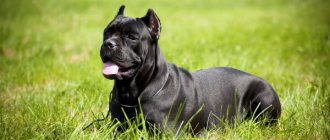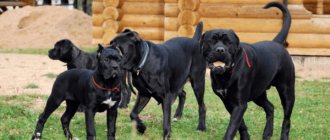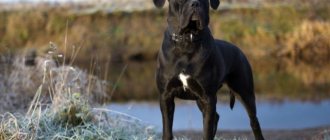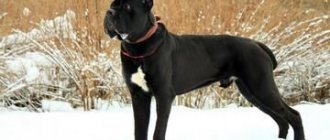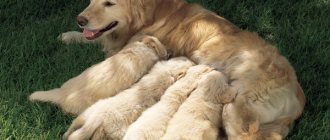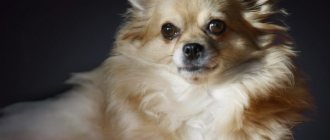When a Cane Corso appears in the house, training and raising the dog plays an important role.
This dog breed dates back to Ancient Rome, and at the genetic level it has a tendency towards guarding and protective functions.
The Cane Corso belongs to the category of large, strong dogs with developed muscles and increased physical activity.
With proper upbringing, she will become a reliable protector for the whole family.
The need for training
Cane Corso are by nature intelligent, good-natured dogs that are great with children. However, like people, animals need gradual development of abilities, i.e. in education and training.
Unlike humans, their behavior is based on instincts.
In the process of evolution of the Cane Corso breed, it received a lot of positive reflexes , which gradually transferred to the genetic level .
In order for them to become the norm of dog behavior, they must be developed as much as possible, suppressing negative and unwanted manifestations.
For a dog, training is training, i.e. development of the necessary instincts.
Constant education and proper training should become an integral part of a pet's life . Only in this case can you raise an intelligent and well-mannered dog.
The Cane Corso is a large dog, and its appearance can frighten people, and incorrect behavior causes panic. Obedience, calmness and a sense of proportion are especially important for this breed.
It is necessary to develop a reserved attitude towards other animals.
Secrets of education
By nature, Cane Corso dogs are highly trainable. Taking into account the psychology of the animal and its individual characteristics, Cane Corsos are happy to follow commands and are prone to obedience.
That is why training can be carried out by the owner himself, if he has sufficient patience and willpower.
At what age should training begin? Raising a dog must be carried out from the first day the puppy appears in the house. The ideal time to start training is 3 months of age, but even before that the pet should be accustomed to the collar and respond to its name. It is advisable to toilet train. Serious professional training is most effective when the dog reaches 3 years of age.
CAREFULLY!
If for some reason the initial stage of education is overdue, then you should not despair.
In principle, the Cane Corso can be trained at any age. You just need to take into account that the older the dog is, the more difficult and longer the training course takes.
Where does education and training begin?
First of all, the following issues need to be resolved:
- Prepare and accustom the dog to a training choke collar with a leash. It is composed of ringed metal links. The size of the collar should exceed the head circumference by 25-30 mm. The leash is made of leather and has a width of 20-25 mm and a length of 2 m. The training collar allows you to control the behavior of your pet, because tugging on the leash causes the loop to tighten, and the dog immediately feels the owner’s reaction.
- A stimulating treat. The first lessons should be based on encouraging the right actions, and a tasty treat is a great incentive. The owner must choose what his pet loves most.
- Choosing a place to study. It should be absolutely safe for the puppy when running and jumping. No one and nothing should distract him from his studies. It is best to choose a place that the dog has already explored. In a new place, unknown smells will constantly distract her. Sniffing will take a long time.
- Providing psychological contact. During training, the owner must remain alone with the pet. Any right actions must be accompanied by affection and kind words.
When conducting training, you need to choose the right voice intonation.
Orders are given in a calm but stern voice. A prohibition requires a demanding, threatening intonation. All encouraging and approving messages are made in a cheerful, gentle voice.
Voice commands are accompanied by gestures, and both must be clear and confident.
The optimal conditions for conducting classes are considered to be an air temperature of about 13-17 degrees in the absence of precipitation and strong wind.
It is better to conduct training in the morning and evening before feeding the dog. You cannot train a sick pet, a nursing dog, or a female dog in heat.
During training, the dog must be given rest . It is recommended to alternate exercises with game elements and free movement.
Bad habits in dogs and how to get rid of them
Bad habits in Cane Corso develop due to improper upbringing or because the owner did not pay enough attention to his pet.
Doesn't like to be alone at home
Left alone, the puppy begins to whine and bark. Usually, this happens if the owners were initially constantly with the pet, but then immediately began to leave it alone for a long time in the house. To accustom a Cane Corso to loneliness, you cannot immediately leave it for a long time, but you must first leave the house for a few minutes, gradually increasing the time of your absence. In the end, the puppy will understand that the owners are not abandoning him and will stop worrying about their absence.
Experienced owners recommend giving your pet a good walk before leaving.
The dog will get tired and sleep until the owners return, and therefore he will have no time left to worry, bark and howl.
Doesn't keep the house clean
When a dog marks corners or dirty furniture, it is first necessary to take it to the veterinarian to rule out any pathology that could be causing the bad behavior. If the results of the examination show that the dog is healthy, then you need to walk him more, paying attention to games and training. You cannot scold a dog for getting dirty in the house if it does not happen in your presence. The animal is not able to understand why it was punished if some time has passed since the “crime”.
And vice versa: you need to praise the dog for doing its “business” on the street. Thanks to this, the animal will quickly understand what is required of it and will stop dirtying the house.
Doesn't come on command
The owner, having brought the pet to the place of walking, lets it off the leash, and when it is time to go home, calls it on command. The dog quickly understands that if it is called, it means it will no longer be able to run and refuses to approach its owner.
The situation is corrected this way: during a walk, the owner calls the pet several times, plays with it or even treats it with a treat, and then lets it run again. In this case, the animal will associate calling on command with something pleasant, and not with the obligation to return home when he still wants to run.
If the walk takes place in the company of other dogs, the owner should from time to time divert the pet’s attention to himself so that the Cane Corso does not decide that his relatives are more important to him.
Call your dog often, distracting it by playing ball or tug-of-war. The company of other dogs and playing with them is important for proper socialization. But when choosing between them and the owner, the dog must always remain with the owner.
Begging at the table
To rid your pet of this bad habit, it is best not to let him into the kitchen while eating. You can lock the dog in the room for this time or simply ignore it. The “Place” command will be useful, after receiving which the dog will have to go to his bed and not leave it without the owner’s permission.
Chews clothes, shoes, furniture and other objects
In most cases, special toys for dogs help solve this problem. If your pet still continues to chew on everything, then you need to try to pay more attention to training and walks.
Just in case, remove things you need away from your dog, as well as items that may be unsafe for him.
Throws itself at strangers and dogs
It is necessary to stop such behavior from the very beginning, preventing conflict situations from arising. If the dog becomes interested in a stranger during a walk and is unfriendly towards him, it is best to take him away from the annoying person or animal.
On the street, the Cane Corso should always be on a leash, with the help of which it is easier for the owner to control his behavior.
Various ways
Cane Corso training can be done in various ways.:
- Taste-enhancing technique. The method is used often and is based on food motivation. For the correct action, the dog receives a tasty treat. The lesson is recommended to be carried out 4-5 hours after feeding. The disadvantage is that not all skills are taught through treats.
- Mechanical technique. It is based on encouraging stroking or forced influence (jerks with a leash, hand pressure, the influence of a training collar). It is used mainly when training with adult animals.
- Contrast method. It combines elements of the 2 previous methods. A treat is used as a reward, and in case of incorrect behavior, mechanical stimuli are used.
- Game method. The main advantage is the reduction of nervous stress on a young dog. Disadvantage: low efficiency. The technique is considered auxiliary and is usually used in combination with other methods of training.
- Imitative way. It is based on the instinct to imitate the behavior of other dogs. The greatest effect is obtained when training in the presence of the mother, from whom the puppy takes an example. The technique can also be used in collective training. It is recommended to use as an additional method in combination with other methods.
- Push method. Its essence is to force the action to be performed using hands or a leash. It can be used at the initial stage of puppy training and should not cause pain.
The choice of training method depends on the dog’s age, its individual characteristics, and the state of the nervous system. When training on your own, it is better to coordinate it with an experienced dog handler.
Expert opinion
Kozhevin Semyon Kirillovich
Expert dog handler.
“An experienced dog trainer is able to accurately determine the most effective way to train a Cane Corso. In early puppyhood, these dogs are easy to train when using a contrasting technique in combination with play elements. This breed is characterized by increased playfulness, which allows you to captivate the puppy and include educational elements in the game. The dog quickly gets used to commands, and correct actions must be rewarded with treats.”
Methods of training - at home, on the court, with a trainer
Where the pet will be trained is determined by the dog owner himself, based on his preferences and capabilities. The choice of training method should also depend on whether the dog’s owner has experience in training other large dogs.
Training a Cane Corso at home has its advantages: the owner chooses a convenient time and place for training with the pet. The absence of irritating factors, such as other animals or strangers, is also important. Finally, no trainer knows the individual characteristics of a puppy and its character better than the owners.
Among the disadvantages, it should be noted that these dogs can be headstrong and overly independent, which creates difficulties during training. For example, a Cane Corso may manipulate its owners during training, or the owners may be too lenient with the pet and will not force it to follow a command.
Self-training a Cane Corso is unacceptable for inexperienced owners.
It is also undesirable if the dog’s owners are too loyal in their treatment of the pet or are indecisive. Only a strong, confident and experienced owner can train a Cane Corso on his own. Classes at a training site have both pros and cons. Their main feature is their focus on the herd instinct, when the animal does what its relatives do. And it is easier for the owner himself, by communicating with the owners of other dogs, to learn the principles of training.
The disadvantages include the lack of an individual approach and the fact that professional trainers often choose the coercion method. But this method of training is not very suitable for Cane Corso: the basis of their training should be mutual respect and encouragement. A dog trained by coercion may grow up to be too aggressive or, conversely, complex.
Classes with a professional trainer at home have their advantages: they can be carried out from any age, and the training process takes into account the individual characteristics of the animal and there are no irritating factors. One of the disadvantages is that, according to experienced owners, it is better to conduct classes with a trainer if the dog has already been trained in basic commands.
Getting Some Skills
One of the first skills to teach your Cane Corso puppy is toilet training.
It is too early to accustom a small pet to the outdoor toilet, and therefore he settles down at home.
To do this, you can use a tray with filler, newspapers or a disposable diaper. They should always be located in one place, and the puppy should do “his business” only here.
In order to toilet train your pet, you need to be patient - this process is quite long . First of all, in the apartment where the puppy has settled, it is better to remove carpets and rugs from the floor - they attract the pet and retain the smell for a long time.
When he relieves himself, he is guided by instincts, and therefore he usually chooses a certain place. This is where the toilet should be placed.
It will be much easier to accustom the animal to such a place.
As a rule, such places are located next to the door, under the window, in the corner or on the balcony . It should be provided with free access at any time and not frighten the pet while relieving itself.
If the puppy has chosen an unsuitable place, then it must be weaned from it. To do this, substances are used that repel the dog.
You can use the Antipis tool . A dog will never defecate where food is located. This option can also be used.
Parenting at home: pros and cons
Pros:
- Individual approach.
- The owner himself determines the time and place of classes.
- The absence of irritating factors and a comfortable psychological environment for the animal.
- Does not require additional investment of money.
- During the training, the owner and his dog get to know each other better and this helps strengthen their relationship.
Minuses:
- A Cane Corso trained at home can manipulate its owner and refuse to follow commands.
- Only a person with leadership qualities and experience in training large dogs can properly train a pet on their own.
- The owner may give incorrect commands to the dog, but due to the lack of professional supervision, he often does not realize this.
Team "Place"
The next important step in raising a puppy is the execution of the “Place” command.
This command carries two meanings . At home, this is how the dog is instructed to go to its bedding and not disturb people. The pet usually quickly understands what they want from him and leaves with resentment for a while. Then he leaves the litter, but no longer gets bored.
IMPORTANT!
On the street the meaning of the command is different. The “place” becomes the object or area to which the owner points.
This command is taught in this way. At home, you can use a taste-enhancing method.
After giving the “Place” command, you should lure the puppy onto its bedding and reward it with a treat. After repeated repetition, this action will become a reflex.
On the street, it is worth thinking about the special skills of the dog - guard . To do this, place a bag or backpack in a certain place that is well known to the animal.
Naturally, the dog’s guard instinct is triggered, and it lies down or sits next to him. Then the owner moves a few meters to the side and calls her to him.
After that, he points to the thing and orders the dog “Place”, and it comes back . After some time, things no longer lie down, but simply pointing to an object is enough. The correct action of the pet should be rewarded.
Bad habits of the Cane Corso
Babies of all dog breeds are similar: they love to play, chew everything they can get their teeth into, and jump on their beloved owner and on his bed.
Spitz training at home for beginners
The difference between this breed is that during the first year and a half of its life the dog will constantly try to expand the boundaries of what is permitted.
As the puppy grows older, it may stop responding to a name, snap when punished, or defend the food it finds. Punishment must be inevitable, but adequate. You cannot hit the puppy with a leash, shout loudly, or call for punishment.
Important! If some time has passed since the offense was committed, it is useless to punish, since the puppy will not associate the owner’s aggression with what he did a long time ago (for example, he chewed off his slippers in the morning and was punished in the afternoon).
It takes time to get a dog to obey you.
Features of executing various commands
When training a puppy, it is important to teach a few basic commands.:
- "To me" . This is a basic command that a puppy learns to use immediately after learning its name. To present it, the dog’s name is clearly stated, and then pronounced in a demanding tone, “Come to me.” At the beginning of training, you should show your pet a treat, which will make him want to follow the command.
- "Ugh" . The command prohibits lifting anything. When teaching, a mechanical method is used. Food is placed on the ground (floor), but when the dog tries to pick it up, a command is pronounced and a prohibiting action is carried out - a tug on the leash, tightening the collar loop, a light slap on the face with a newspaper or a fly swatter on the head. The action must indicate the existence of danger posed by the object.
- "Near" . With this command, the puppy must stand close to the owner on the left. When training the puppy, the correct execution of the command is indicated with the help of a leash, and after its execution, he is rewarded with a treat.
- "Sit" . This command is duplicated by raising the palm to chest level, while the arm is moved to the left side. When training with your fingers, the dog's pelvic area (lower back) is pressed. With such pressure, the animal’s instinct is triggered, and it sits down. Don't forget about encouragement.
- "Lie" . For a guard dog, this command is important. In order for the puppy to comply with the command, you need to press with your hand in the area between the shoulder blades. After execution - an incentive.
- "Exposure" or "Wait" . The command can be performed while standing, lying down or sitting. In the first case, the dog must remain in a given position for at least 10-15 seconds, and in the second - up to 0.5 hours. Compliance is achieved by rewarding with a treat. At first, the owner does not leave the dog’s visibility, but gradually disappears as the interval of absence lengthens.
- "Give" . Initial exercises are carried out with a puppy toy. After pronouncing the command, the toy is taken from the puppy’s mouth, and his attention is diverted to another object. Action is encouraged. Skills are reinforced with food (a bowl of food, a bone). If the puppy shows aggression, it is recommended to apply pressure with your hand in the area between the shoulder blades, forcing him to lie down. With such training, it is important that the dog understands who is “boss” in the house. She must give away any item.
- "Aport" . Classes to master this command are held outside the home. During the first “lessons,” a favorite dog toy is used. She rushes, then the puppy runs and grabs her. Next the command “Come to me” sounds, and after its execution - “Give”. In subsequent classes, you can use any other items. Usually dogs engage in such training with pleasure, because... it's very game-like.
- "Face" . This team should be the final one in training. It is only permissible for an obedient dog, because... can teach unexpected aggression. For training, an assistant with protective clothing is required. Training is carried out when the dog reaches one year of age.
The listed commands can be attributed to the basic set. Training is carried out alternately.
Some of them are impossible without mastering other skills.
In general, the duration of training for puppies should not exceed 45-60 minutes with rest breaks.
Training an adult dog
When the puppy age for training is missed, it can be done with adult dogs, but this will require special patience. The animal has already developed certain reflexes, and its psychology must be taken into account during training.
NOTE!
The most important thing is to teach your dog to behave correctly outside.
To do this, first of all, you will need commands such as “Nearby”, “Exposure”, “Wait”, “Sit”. In principle, the training is not much different from training puppies, but in the incentive part you should not get carried away with treats.
For an adult dog, vocal and mechanical, caressing encouragement is very important.
You can’t scold her, but praise will give the desired result.
You should talk to your dog more.
A serious problem arises when an adult dog displays unprovoked aggression towards people or animals on the street. First of all, we need to find out the reasons for this behavior.
Very often her instinct to protect her territory is triggered (shown in the photo) . In this case, it is necessary to remove as much as possible objects that may become the object of protection.
You may need to change your walking location to prevent your dog from becoming accustomed to one area.
Raising the breed
To raise a Cane Corso puppy well, you need to pay attention to a number of key points that play a decisive role in upbringing - heredity, imprinting and socialization.
Using these three components, you can turn your puppy into a well-mannered, serious, but balanced protector.
Heredity . To begin with, in order for the puppy to respond well to training and not have character problems in the future, you should pay attention to the breeder and approach his choice with all seriousness.
An experienced breeder will never use for procreation a representative of the breed who has shown his “bad” character.
And in the behavior of the Cane Corso, most factors are transmitted genetically, so in this way you can protect yourself from unnecessary problems in education.
Imprinting . Typically, imprinting refers to the cub copying the behavior of adults, including parents, which occurs in puppies at the age of 3-6 weeks.
At this time, they learn to realize who is “their own” and who is the “stranger.” It is very important that during this period there are people nearby, as many people as possible, whom the dog will study and sniff.
If there is enough communication with people at this stage, then in the future the puppy will perceive them as representatives of his kind.
This means that the dog will not be overly aggressive towards them, and at the same time will not be afraid of them. Thus, she will make an excellent guard and loyal friend.
Socialization . It must be remembered that raising a dog is not only about training and teaching commands. This is also spending time together, communicating with family, walking, playing.
In order to help your dog socialize, you need to encourage its desire to communicate.
Correct it in the desired direction, teach it to show your emotions. Giving your dog enough time can help prevent excessive aggression and other negative aspects of behavior.
Step-by-step training
When training a Cane Corso, it is important to take into account the age characteristics of the dog.
We can distinguish the following main stages of education and training::
- Up to 3 months. It is considered optimal to purchase a puppy at the age of 2-4 weeks. He does not yet feel fear of novelty and easily adapts to a new environment. Fear appears around the age of 2-2.5 months, and such puppies require special attention. During this period, it is important to create confidence in your pet’s safety. He must master the entire apartment and assimilate all the familiar smells. It is necessary to provide his own place, which cannot be touched by strangers. At this stage, the commands “Place” and “Fu” are taught.
- Age 4-5 months. During this period, vaccination is completed, and the puppy can be taken outside the home. You can start teaching the commands “Come to me”, “Sit”, “Lie down”, “Near”, “Give”. It is useful to start socializing with other dogs. At this stage, it is important to promptly stop emerging aggression, excessive caution and timidity. A reasonable balance of activity and caution must be ensured.
- Age 6-7 months. The dog develops a “pack” instinct. She begins to look for her place in the hierarchy. It is important not to miss the moment, because the role of the “leader” is being decided, and the authority of the owner must remain unquestioned. The learned commands can be replenished - “Fetch”, “Voice”.
- Age 8-12 months. This is a difficult stage of puberty and hormonal surges. The dog develops aggression towards dogs of the same sex. At this stage, sometimes you have to periodically repeat previously learned commands. During this period, fear and phobias develop especially actively, which should not be allowed.
- Up to 4 years of age. This is the dog's maturity stage. It is still possible to carry out training, but it must be done taking into account the current psyche. Starting from the age of one, you can teach the “Face” command. If necessary, professional training is provided as a watchman. At this age, you cannot put too much pressure on the animal’s psyche, humiliate and oppress it. It is strictly not recommended to hit a dog.
Raising and training a pet, in principle, occurs throughout its life.
Periodically it is worth reminding half-forgotten skills and getting rid of unwanted reflexes.
Training at 4 - 5 months
By this time, the Cane Corso puppy has already become accustomed to your home and usual walking areas, and no longer needs your support and care so much. He begins to flirt with other dogs, pretend that he does not hear you when you call him, and show a certain persistence and disobedience when performing various commands.
This means it's time to move on to full training . In classes at this age you can already be persistent and demanding. At the same time, the most important thing is not to overdo it, remember that classes should bring joy to both you and your dog, and only then you can achieve the desired result.
Required commands in 4 months
What commands are practiced by a Cane Corso puppy at 4 months:
- Calm movement next
to the owner with and without a leash, with landing when stopping, with a change in pace and direction of movement - Return to you
upon request - Staying
in a free or certain position (sitting, lying, standing) for a long time: if necessary, wait for the owner on the street, when visiting a store or other establishment - Indifferent attitude towards treats scattered on the ground
- Inhibitory command
to stop unwanted actions - Execution of a set of commands “sit”, “lie down”, “stand”
at a distance and near the leg, when giving commands by voice and gestures - Stop barking
on demand.
